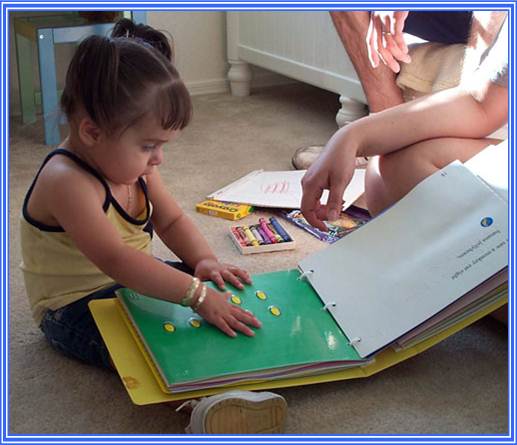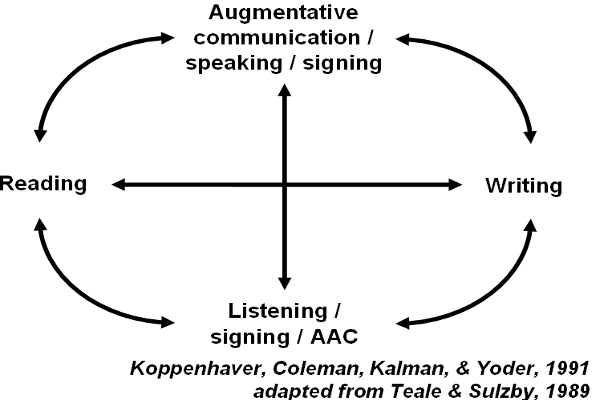
Communication and Emergent Literacy: Early Intervention Issues, Session 4
Powerpoint presentation providing a comprehensive introduction to Emergent Literacy for infants and toddlers with visual impairments.
By Cyral Miller
Selections excerpted and adapted from Session 4 of The Communication and Emergent Literacy: Early Intervention Issues module by Wendy K. Sapp, Ph.D., and Deborah D. Hatton, Ph.D. See attached powerpoint for the complete presentation.
Emergent Literacy Begins at Birth
Emergent literacy is the developmental process that begins at birth through which children gain a foundation for reading and writing.
Emergent Literacy is Appropriate for all Children
Disability, as well as the reactions of others to disability, can result in fewer opportunities for children to experience literacy.
Children with disabilities, including children with visual impairments, can and do experience literacy success when provided with appropriate support and modifications.
Family Literacy
Families are essential to emergent literacy development. Reading and writing are usually first introduced to children in the home. Researchers have repeatedly found that the home literacy environments of toddlers and preschoolers have measurable effects on later literacy skills.
Family Literacy Characteristics
Family and environmental characteristics that are related to literacy include
- a variety of literacy activities in the home (e.g., many books and writing materials that are used regularly),
- language and vocabulary used in the home,
- opportunities for children to learn about people and activities, and
- high parental expectations for child literacy.
Bennett, Weigel, & Martin, 2002
Concurrent and Interrelated Development of Literacy
Emergent literacy is based on the idea “that reading, writing, and oral language develop concurrently and interdependently from an early age from children’s exposure to interactions in the social contexts in which literacy is a component, and in the absence of formal instruction” (p. 849).
Whitehurst & Lonigan, 1998
The Interrelationships of Literacy Development

Functional Literacy Events
Functions and forms of literacy are equally important in the development of reading and writing. Young children learn the forms and functions of literacy concurrently through functional literacy experiences (e.g., writing a grocery list with a parent before going grocery shopping). Meaningful literacy involves practicing
Two Important Models of Emergent Literacy
- Whitehurst and Lonigan’s Two Domains of Emergent Literacy
- Sénéchal, LeFevre, Smith-Chant, and Colton (2001)
Sénéchal et al. propose that literacy evolves from skills and abilities that form three separate, but related, constructs: emergent literacy, language, and metalinguistic skills.
National Early Literacy Panel (NELP)’s 11 Predictors of Literacy Success
- oral language/vocabulary
- listening comprehension
- print knowledge
- environmental print
- alphabetic knowledge
- invented spelling
- phonemic awareness
- phonological short-term memory
- rapid naming
- visual perceptual skills
- visual memory
Strickland & Shanahan, 2004
Three Contexts
Three contexts influence communication development:
- Communicative context—linguistic and nonlinguistic interactions among children and adults
- Situational context—physical characteristics of children’s living and learning environments
- Sociocultural context—societal and cultural values, expectations, beliefs, and resources
Recommended Practices
To help develop emergent literacy in young children with disabilities, early interventionists should provide collaborative, family-centered support that is developmentally appropriate and based on evidence-based and recommended practices that result in functional outcomes within naturally occurring learning opportunities.
Family-Centered and Collaborative Practices
Interventions to facilitate emergent literacy
- should be family centered:
- involve shared responsibility and collaboration among all team members,
- strengthen family functioning,
- include individualized and flexible practices, and
- employ strengths- and assets-based practices.
Trivette and Dunst, 2005
Developmentally Appropriate Practices
Although most definitions of emergent literacy recognize that it begins at birth, very little is known about emergent literacy in infants and toddlers…Therefore, until we have more empirically based information, families, caregivers, and professionals should use developmentally appropriate activities that are functional and fun, use recommended practices from early intervention and early childhood special education, and carefully consider research and evidence-based practices that may be appropriate for infants and toddlers.
Recommended Practices for Child-Focused Interventions
Intervention that is child-focused includes
- designing safe and accessible environments that promote active and interactive engagement,
- adapting practices to meet the individual and changing needs of each child, and
- systematically promoting children’s learning within and across environments, activities, and routines.
Wolery, 2005
Child-focused interventions should promote functional outcomes as identified by the Early Childhood Outcome Center (2005):
- social interactions that provide the context for meaningful communication and that provide motivation for development across domains,
- active engagement in the world around them, and
- independence and self-efficacy.
Emergent Literacy Interventions
Strategies and interventions to facilitate emergent literacy facilitate the development of the six key components of emergent literacy for young children with disabilities:
- oral language,
- phonological awareness,
- concept development,
- knowledge of the conventions of print/braille and print/braille intentionality,
- alphabetic knowledge, and
- rich literacy environments.
Strategies and Interventions to Facilitate Emergent Literacy
Developmentally appropriate strategies and interventions that promote functional outcomes include
- play;
- routines-based literacy;
- responsive literacy environments;
- shared storybook reading (especially dialogic reading, storybook preview, and storybook sounds);
- storytelling, including decontextualized language; and
- dialogue/conversation.
Assessment of Emergent Literacy
Current level of functioning descriptions of communication and language can be used to identify emergent literacy intervention goals for children.
Assessment of family priorities, concerns, and resources can also be used to identify communication, language, and emergent literacy priorities and goals.
Sensory assessments describe current levels of visual and sensory functioning and sensory preferences that can help guide intervention.
Sensory Assessments and Emergent Literacy
Functional vision assessments, conducted by teachers of children with visual impairments, describe functional use of vision across settings that can be used to identify appropriate and accessible literacy media.
A developmentally appropriate learning media assessment (DALMA) consists of interviews and observations and is used to describe children’s sensory behaviors and preferences.
Developmentally Appropriate Learning Media Assessment Tools
The Individual Sensory Learning Profile Interview or ISLPI (Anthony, 2003a) includes questions for caregivers about how a child with visual impairments uses sensory information during activities and routines.
The Observational Assessment of Sensory Preferences of Infants and Toddlers With Visual Impairments or OASP (Anthony, 2003b) provides a framework for direct observations of the child’s sensory behaviors.
The Adult/Child Interactive Reading Inventory (ACIRI)
The ACIRI is an authentic observation tool that assesses interactions during shared storybook readings and helps interventionists identify intervention goals and strategies.
DeBruin-Parecki, 2000
Kaderavek-Sulzby Bookreading Observational Protocol (KSBOP)
The KSBOP is used to observe joint reading behaviors of children and caregivers.
Kaderavek & Sulzby, 1998
Impact of Disabilities and VI on Emergent Literacy
Early interventionists should carefully consider children’s unique abilities and the impact they may have on
- oral language (listening comprehension and vocabulary development in particular),
- phonological awareness,
- concept development,
- knowledge of the conventions of print/braille and of print/braille intentionality, and
- alphabetic knowledge.
Learning Media and Emergent Literacy
Determining a child’s primary literacy medium or media is a complex process. Intervention teams should carefully and thoughtfully consider recommendations for children’s primary literacy media. If children have a visual condition that results in progressive vision loss or that may lead to future vision loss, early exposure to braille and tactile experiences should be provided. The developmentally appropriate learning media assessment should be used to provide ongoing guidance regarding children’s current sensory preferences and primary literacy medium or media.
This power point presentation from the Early Intervention Training Center for Infants and Toddlers With Visual Impairments FPG Child Development Institute (2005) provides a comprehensive introduction to Emergent Literacy for infants and toddlers with visual impairments.
